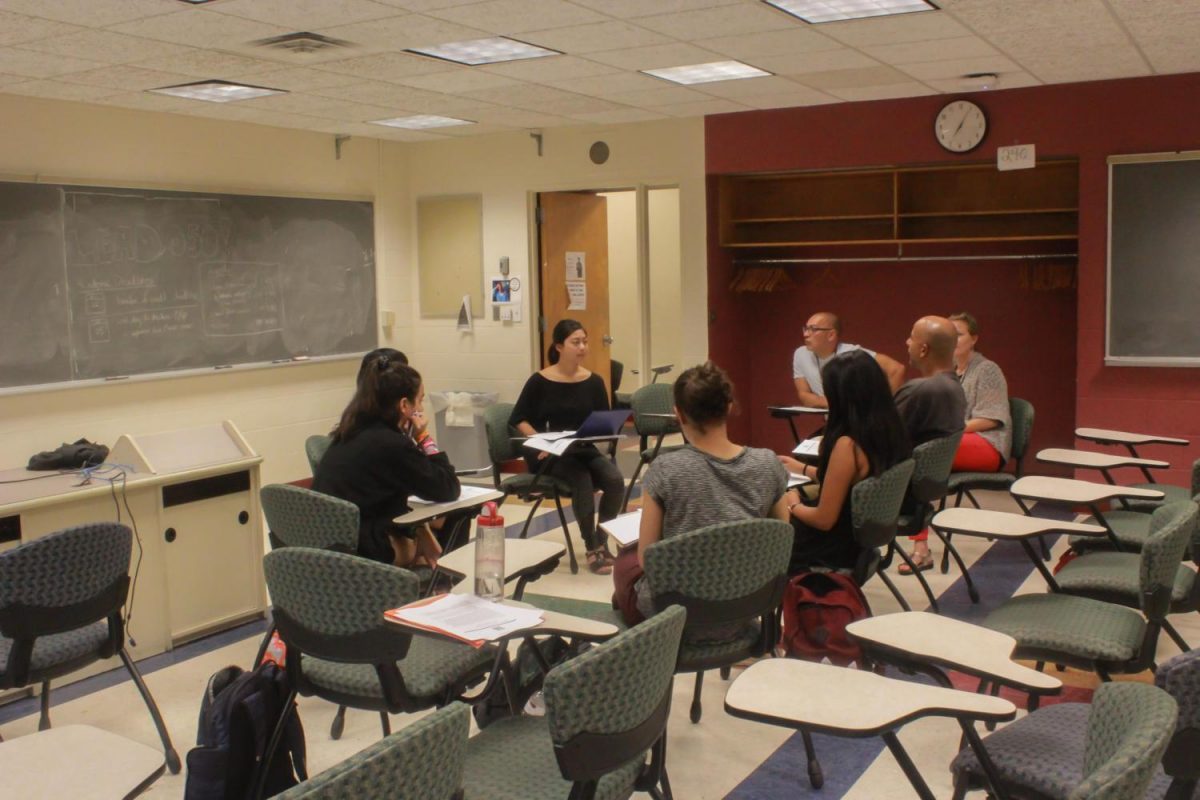First-Year Program Encourages Community, Confidence
College sophomore Kara Nepomuceno leading a PAL meeting. PAL was created this year to help first-years acclimate to college life under the leadership of student advisors.
The Office of the Dean of Students initiated a new advising and orientation model this semester. The program, the Peer Advising Leader initiative, pairs student advisors with first-years in a semester-long program to help them adjust to college life.
Unlike the ambassador program — the orientation model from previous years that paired first-years with older students — the PAL program extends far beyond orientation to include an optional semester-long course called Introduction to Oberlin Life and Learning. Students who chose to participate in this course are required to attend six PAL-led sessions covering topics such as study strategies, time management, academic integrity, and Winter Term planning.
Those who signed up for the program were separated into cohorts of around 15 peers, often comprised of students from the same first-year-seminar class.
Each cohort is led by a student who has experienced first-year orientation and gone through PAL training. This student, or Peer Advising Leader, uses their knowledge of college life to engage first-years about the Oberlin experience, theoretically easing the first-year transition and making it less intimidating.
The goal of the program is to help students “acclimate to college learning, use institutional resources for holistic support, navigate college life, and create an educational pathway that connects past and present curricular and co-curricular experiences to goals for their future,” according to PAL’s website.
Another goal of the program is to create a sense of community among students, according to Associate Dean of Students Dana Hamdan, who is the director of the PAL program.
“We all pride ourselves on Oberlin’s abundant educational resources,” Hamdan said. “If the new advising system can help first-year students get a fast start in learning to access those resources, that will have a significant long-term compounding effect on the richness of their entire college experience. The PAL initiative is focused [on]supporting that fast start.”
The students in each cohort are generally split among three academic advisors, who attend numerous PAL sessions to build a better relationship with the students and encourage them to make use of the academic advising resources that Oberlin has to offer. This way, students can get to know their advisors and feel more comfortable setting up appointments when they need them.
“It was nice to meet [the advisors] in a PAL setting before meeting them one-on-one,” College first-year Jacqueline Steel said.
Many of the students enrolled in the PAL program said that it has been crucial in helping them navigate the new environment.
“I like that there is a space for first-years to get together with someone who is not a first-year and talk about our problems and talk about solutions, because as a first-year, I feel lost,” College first-year Julia Crewe-Kluge said.
However, some students believe the time commitment isn’t worth it.
“I feel like I’ll learn everything about Oberlin just by experience,” said College first-year Ellie Loane, who decided not to take Introduction to Oberlin Life and Learning this semester. “I found it a bit redundant to add extra space in my schedule.”
College junior and PAL Marcus Hill said the program could act as an additional resource for first-years, particularly through stressful or difficult times.
“I feel like there’s never an easy way to throw students in and have good advisors,” Hill said. “But I feel like working with the PAL group, it’s probably beneficial in the long-term in that if anyone has a negative experience, they would probably be more likely to explain it to someone in their cohort.”
In addition to the new peer-centered support system, administrators have also remodeled the first-year advising experience and orientation process.
Orientation saw the introduction of semester “learning goals” that first-years presented to their academic advisors. These are intended to help advisors understand the short- and long-term goals of their students so that they can better assist them.
The College has also purchased new advising software that is being tested out with first-years’ advisors. This is intended to assist with the lack of any central communication platform within departments.
The new software, AdviseStream, costs $25,000 a year and acts as a hub for advisors, academic deans, and other departments. The software will offer aid in tracking students’ coursework and co-curricular activities to provide a more comprehensive plan for each student. The software will be introduced to the rest of the College in stages.
“It is powerful but also complicated software that needs to communicate with many of Oberlin’s databases and other software,” Hamden said. “When fully in place, it will offer advisors and students [the] tools to manage their entire advising-related activities in one place. It also has an awesome digital communication system that encourages collaboration and streamlines administrative processes.”
The changes in the advising system and the addition of AdviseStream software will allow faculty to approach academic mentorship in a whole new way.
Faculty advisors currently take on an average of five incoming students. In years past, the average advising load has been six or seven students per advisor each semester. Workshops were offered in August for advisors to discuss successful approaches and get advice on handling new struggles. Those who attended received a $100 stipend.
“The advising program will continuously strive to provide a better, more supportive advising environment,” Hamden said. “Currently, we are focused on getting input from PALs, first-year students, and academic advisors who have been generous in providing constructive feedback. As with any pilot program, there is room for improvement, and we are already learning a tremendous amount in just this first month of operation. We are focused on supporting the best learning outcomes for students and will make any and all changes that serve that end.”
These changes were spearheaded by the Advising Task Force, a subgroup of the Strategic Plan Implementation Committee. The Strategic Plan, first adopted by the General Faculty Committee in Feb. 2016, includes 28 strategic recommendations and goals, including one aiming to improve the advising and overall support structures for students.
The plan stated that its goal was to “create individually tailored, equitable systems of guidance and support that help students build personally meaningful pathways through the curriculum — from first-year seminars to culminating experiences — along with mentoring, advising, and coaching that help students connect their academic, artistic, personal, social, and professional development at Oberlin and beyond.”
Last year, the task force sent out a survey seeking information regarding student advising experiences and found widespread dissatisfaction with the previous first-year model. They found that 94 percent of sophomores and juniors who responded wished that they had had additional advising resources during their first year. 73 percent of these students also reported that Oberlin does not convey clear expectations about academic advising.
Senior Associate Dean of the College David Kamitsuka said the survey results are what sparked the new advising model.
“Providing additional advising support throughout the semester and educating new students about the important learning goals for first-year academic advising became a priority for the task force,” Kamitsuka said.
Based on preliminary data collected from first-years, the PAL program and new advising model could mend this deficit. 88 percent of students reported having a positive educational experience with their PAL, and 70 percent of respondees said their PAL advising sessions were helpful in supporting their transition to Oberlin.
Over a five-year time period, the Task Force plans to readdress the second year experience, Winter Term advising, and major advising. It also plans to develop and invest in “Oberlin 4+4,” which is a new model that would aid advisors in better mentoring and in promoting student success even after they leave Oberlin.







